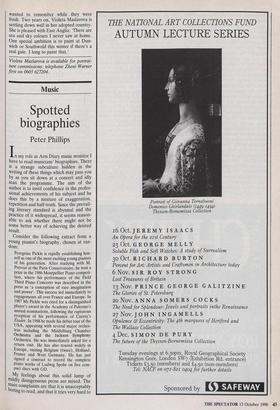Exhibitions 2
Violeta Maslarova (Charlotte Lampard Gallery, 22 October - 5 November)
Under a different sky
John Henshall
In late December 1988, Violeta Maslar- ova, one of Bulgaria's leading painters during the Zhivkov era, was sitting in an elderly camper van on the Yugoslav border with her daughter and English son-in-law hoping that the guards would not find the canvases they had secreted beneath an old mattress and piles of family bric-a-brac. It had taken a two-year battle with the authorities in Sofia and the Home Office in London to get this far, and she was praying that nothing should go wrong now.
It didn't. With the faint yet unmistakable whiff of perestroika on the wind, the border guards of the Balkan state which for 40 years was Moscow's closest, least ques- tioning ally, no longer had their hearts in it. If she had the papers, let her go. They poked about unenthusiastically in the back of the van, but among the mementoes of half a lifetime's dedicated creativity, they found nothing more suspect than a couple of saxophones; she could take those.
Just days after arriving in England in January 1989, Maslarova, wrapped up against a wicked east wind, was painting again. Now, however, the artist who had been hailed as Bulgaria's Kokoschka, the closet Expressionist who kept a step ahead of the regime's diktats, was staring out at a winter sea utterly unlike that at Burgas, the port-cum-artistic colony on the Black Sea where she had lived for 40 years. She was at Holkham, in north Norfolk, where as thunderous waves broke before her, it was hard to tell where sky ended and sea began.
Now Violeta Maslarova is to have her first solo exhibition in this country, at the Charlotte Lampard Gallery (33 Mossop Street, SW3). I met her, now in her mid-60s, at her daughter's home in Nor- wich. With Zheni — also an artist — as translator where needed, we retraced the occasionally bizarre career of the woman who describes herself as 'never pushy enough', yet who in Bulgaria is the equiva- lent of an RA and has been honoured by the state.
`When I was a child, I painted all the time, but my mother didn't think art could keep me. We have a saying, "You can be a great violinist, but still can't feed the family".' However, Maslarova's grand- mother, who ran a crafts shop, had been told of her talent by her art teacher, and intervened. 'My grandma really threw her weight about . . . all six stone of her!' There was no argument after that.
In 1944, Maslarova went to the Academy of Art in Sofia. The course lasted six years and she had to join the Artists' Union, the CBX; perhaps surprisingly, she did not have to join the Communist Party. Indeed, whatever their private thoughts about Zhivkov, good artists made a com- fortable living. Maslarova made 1,000- 1,500 leva a picture. (The average monthly wage was 80 leva, and one lev is about £1.) After qualifying, Maslarova moved to Burgas, noted for its 'Colourist' school and `Friends of the Sea' exhibitions. She pre- ferred the old port to Sofia. 'It was idyllic. I had a roof-top flat and studio, looking out over the Black Sea. I felt so much freer. I had the name, so I got the work.' She became a well-known artist, with a knack of sidestepping odd taboos the regime imposed. 'Anything abstract, they hated. They wanted "socialist realism". Many artists just painted in the nearest factory. You had to sell to public bodies anyway there were few private buyers then. But I loved the sea and the sailors and fisher- men. Well, they were workers too, and I could do my Expressionism depicting the settings. You could get round these things . . .!'
Maslarova also painted portraits of Zhiv- kov, Khrushchev, Brezhnev and many other older Eastern bloc leaders. `Often they were too busy to sit. They would send a photo. Please paint me from this, they'd say.' She exhibited throughout eastern Europe, and in Austria and Greece. Her flawless colour sense, bold use of thick, glutinous paints and impasto, and equal proficiency in oils, watercolours and pas- tels marked her out. Yet Bulgaria was still isolated. Her teachers, like Detchko Dzu- nov and Nicola Ganushev, had studied in Italy and Germany, yet most of her best contemporaries are all but unknown here: Roussev Sotirou, Petrov, Dubova, Parpu- lova and the Albanian-born Janko are a few. She tips Dimitar Kirov, Entcho Pironkov and Stojan Tzanev as younger names to watch.
The coming London show concentrates on sea- and landscapes: of East Anglia, at Holkham, Wells, Dunwich and Alde- burgh, and of Bulgaria, scenes of the beaches and fishing communities she Violeta Maslarova's East Anglian landscape, Wolkham: One Boy and His Dog'
wanted to remember while they were fresh. Two years on, Violeta Maslarova is settling down well in her adopted country. She is pleased with East Anglia: 'There are sea and sky colours I never saw at home. One special ambition is to paint at Dun- wich or Southwold this winter if there's a real gale. I long to paint that.'
Violeta Maslarova is available for portrai- ture commissions: telephone Zheni Warner first on 0603 627204.



























































 Previous page
Previous page